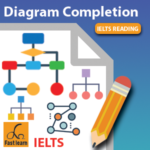Dạng câu hỏi này đánh giá khả năng hiểu viết dạng đồng nghĩa và tóm tắt ý chính khi đọc bài của thí sinh.
Chú ý:
- Tốc độ đọc cần đủ nhanh để giúp người đọc tổng quát nội dung chính của đoạn, tránh sa vào chú ý đến tiểu tiết.
- Đọc đề kĩ để biết đề yêu cầu đọc những đoạn nào. Ví dụ đề yêu cầu đọc đoạn B, C, E, F, G thôi thì khi bạn đọc đoạn A và D để tìm heading thì bạn đang phí thời gian
làm điều mà đề không yêu cầu. - Gạch bỏ những câu trả lời dùng trong ví dụ để khỏi mất thời gian mắt bạn phải scan nó vì chắc chắn câu này sẽ không được dùng lại. Tương tự, heading nào đã được chắc chắn xác định thì bạn nên gạch ngang luôn để giảm việc phí thời gian đọc đi đọc lại heading list cho các câu trả lời khác.
- Câu nào không chắc chắn thì nên đánh dấu hỏi, ghi chú lại lý do bạn phân vân giữa nó với lựa chọn nào khác à rất tiện khi muốn quay lại kiểm tra và làm phương pháp loại trừ. Nếu không ghi chú lại, bạn sẽ quên và khi nhìn lại lựa chọn ấy, bạn phải mất thời gian đọc lại đoạn để có lại nhận định lúc đầu rồi mới quyết định được.
- Có thể đọc câu đầu và câu cuối của mỗi đoạn để nếu chúng là câu chủ đề thì chỉ việc đọc sâu vào đoạn để kiểm chứng chủ đề đó có xuyên suốt cả đoạn không thôi.
- Đây là loại câu hỏi duy nhất ta không nên đọc câu hỏi trước khi đọc bài đọc. Vì nếu đọc các headings trước các bạn cũng sẽ rất khó nhớ chúng, lại phải đọc lại mất thời gian. Nhưng nguy hiểm hơn là khi đọc heading, bạn bị cuốn vào những bẫy về
thông tin chi tiết trong headings. Những headings sai sẽ chứa thông tin chi tiết
rất dễ tìm trong bài, và khi đọc heading xong bạn qua đọc đoạn sẽ thấy thông
tin ấy và lầm tưởng đó là heading đúng trong khi nó chỉ là 1/5, hay 1/3 ý của
đoạn đó chứ không phải ý chính. Vì vậy bạn nên đọc đoạn văn trước, và theo các
bước được nói rõ bên dưới.
Các bước làm làm dạng câu hỏi này:
- Bước 1: Đọc
tiêu đề, phần giải thích tiêu đề subtitle, xem các hình minh họa để biết chủ đề
bài đọc + đọc yêu cầu đề xem cần đọc đoạn nào để trả lời câu hỏi, gạch câu trả
lời example khỏi danh sách. - Bước 2: đọc
nhanh qua các đoạn văn và tóm tắt nó theo ý của bạn. Bạn có thể
tóm tắt bằng tiếng Việt/tiếng Anh, bằng 1 từ, 1 cụm từ, 1, 2 câu tùy theo cách
bạn hiểu thông tin. - Bước 3: so sánh tóm tắt của bạn với danh sách
heading, cái nào gần nghĩa nhất với tóm tắt của bạn thì chọn làm câu trả lời.
Chúng ta áp dụng các bước phía trên vào bài đọc sau:
Bước 1:Đọc tiêu đề, xem các hình minh họa, để biết chủ đề bài đọc à bài này không có tiêu đề, nhưng không lo, thường thì chúng ta đọc 1 passage để trả lời 13-14 câu hỏi, và việc đọc các câu hỏi khác dạng heading matching sẽ giúp ta nắm được nội dung chính của bài đọc. Bạn có thể đọc bài Nhận diện bố cục bài đọc khi áp khung câu hỏi vào nội dung đọc để
nắm rõ hơn vấn đề này.
Đọc yêu cầu đề ta thấy ta cần chọn headings cho đoạn A, B, C, D, và F (bỏ qua đoạn E)
Chúng ta không đọc heading list mà đi thẳng vào đọc các đoạn như yêu cầu ở trên.
Questions 1 – 5
The passage has six sections A-F.
Choose the
correct heading for sections A-D and F from the list of headings
below.
i The probable effects of the new international trade agreement
ii The environmental impact of modern farming
iii Farming and soil erosion
iv The effects of government policy in rich countries
v Governments and management of the environment
vi The effects of government policy in poor countries
vii Farming and food output
viii The effects of government policy on food output
ix The new prospects for world trade
Bước 2: đọc từng đoạn và tóm tắt ý chính đoạn đó theo cách hiểu và ngôn ngữ của bạn.
Section A
The role of
governments in environmental management is difficult but inescapable.
Sometimes, the state tries to manage the resources it owns, and does so badly.
Often, however, governments act in an even more harmful way. They actually
subsidise the exploitation and consumption of natural resources. A whole range
of policies, from farm-price support to protection for coal-mining, do
environmental damage and (often) make no economic sense. Scrapping them offers
a two-fold bonus: a cleaner environment and a more efficient economy. Growth
and environmentalism can actually go hand in hand, if politicians have the
courage to confront the vested interest that subsidies create.
Section B
No activity
affects more of the earth’s surface than farming. It shapes a third of the
planet’s land area, not counting Antarctica, and the proportion is rising.
World food output per head has risen by 4 per cent between the 1970s and 1980s
mainly as a result of increases in yields from land already in cultivation, but
also because more land has been brought under the plough. Higher yields have
been achieved by increased irrigation, better crop breeding, and a doubling in
the use of pesticides and chemical fertilisers in the 1970s and 1980s.
Section C
All these
activities may have damaging environmental impacts. For example, land clearing
for agriculture is the largest single cause of deforestation; chemical
fertilisers and pesticides may contaminate water supplies; more intensive
farming and the abandonment of fallow periods tend to exacerbate soil erosion;
and the spread of monoculture and use of high-yielding varieties of crops have
been accompanied by the disappearance of old varieties of food plants which
might have provided some insurance against pests or diseases in future. Soil
erosion threatens the productivity of land in both rich and poor countries. The
United States, where the most careful measurements have been done, discovered
in 1982 that about one-fifth of its farmland was losing topsoil at a rate
likely to diminish the soil’s productivity. The country subsequently embarked
upon a program to convert 11 per cent of its cropped land to meadow or forest.
Topsoil in India and China is vanishing much faster than in America.
Section D
Government
policies have frequently compounded the environmental damage that farming can
cause. In the rich countries, subsidies for growing crops and price supports
for farm output drive up the price of land. The annual value of these subsidies
is immense: about $250 billion, or more than all World Bank lending in the
1980s. To increase the output of crops per acre, a farmer’s easiest option is
to use more of the most readily available inputs: fertilisers and pesticides.
Fertiliser use doubled in Denmark in the period 1960-1985 and increased in The
Netherlands by 150 per cent. The quantity of pesticides applied has risen too:
by 69 per cent in 1975-1984 in Denmark, for example, with a rise of 115 per
cent in the frequency of application in the three years from 1981.
In the late
1980s and early 1990s some efforts were made to reduce farm subsidies. The most
dramatic example was that of New Zealand, which scrapped most farm support in
1984. A study of the environmental effects, conducted in 1993, found that the
end offertiliser subsidies had been followed by a fall in fertiliser use (a
fall compounded by the decline in world commodity prices, which cut farm
incomes). The removal of subsidies also stopped land-clearing and
over-stocking, which in the past had been the principal causes of erosion. Farms
began to diversify. The one kind of subsidy whose removal appeared to have been
bad for the environment was the subsidy to manage soil erosion.
In less enlightened countries, and in the European Union, the trend has been to reduce
rather than eliminate subsidies, and to introduce new payments to encourage farmers to treat their land in environmentally friendlier ways, or to leave it fallow. It may sound strange but such payments need to be higher than the existing incentives for farmers to grow food crops. Farmers, however, dislike being paid to do nothing. In several countries they have become interested in the possibility of using fuel produced from crop residues either as a
replacement for petrol (as ethanol) or as fuel for power stations (as biomass). Such fuels produce far less carbon dioxide than coal or oil, and absorb carbon dioxide as they grow. They are therefore less likely to contribute to the greenhouse effect. But they are rarely competitive with fossil fuels unless subsidised – and growing them does no less environmental harm than other crops.
Section E
In poor
countries, governments aggravate other sorts of damage. Subsidies for
pesticides and artificial fertilisers encourage farmers to use greater
quantities than are needed to get the highest economic crop yield. A study by
the International Rice Research Institute of pesticide use by farmers in South
East Asia found that, with pest-resistant varieties of rice, even moderate
applications of pesticide frequently cost farmers more than they saved. Such
waste puts farmers on a chemical treadmill: bugs and weeds become resistant to
poisons, so next year’s poisons must be more lethal. One cost is to human
health. Every year some 10,000 people die from pesticide poisoning, almost all
of them in the developing countries, and another 400,000 become seriously ill.
As for artificial fertilisers, their use world-wide increased by 40 per cent
per unit of farmed land between the mid 1970s and late 1980s, mostly in the
developing countries. Overuse of fertilisers may cause farmers to stop rotating
crops or leaving their land fallow. That, in turn, may make soil erosion worse.
Section F
A result of the Uruguay Round of world
trade negotiations is likely to be a reduction of 36 per cent in the average
levels of farm subsidies paid by the rich countries in 1986-1990. Some of the
world’s food production will move from Western Europe to regions where
subsidies are lower or non-existent, such as the former communist countries and
parts of the developing world. Some environmentalists worry about this outcome.
It will undoubtedly mean more pressure to convert natural habitat into
farmland. But it will also have many desirable environmental effects. The
intensity of farming in the rich world should decline, and the use of chemical
inputs will diminish. Crops are more likely to be grown in the environments to
which they are naturally suited. And more farmers in poor countries will have
the money and the incentive to manage their land in ways that are sustainable
in the long run. That is important. To feed an increasingly hungry world,
farmers need every incentive to use their soil and water effectively and
efficiently.









